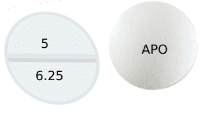Uses
Benazepril is used alone or in combination with other medications to treat high blood pressure. Benazepril is in a class of medications called angiotensin-converting enzyme (ACE) inhibitors. It works by decreasing certain chemicals that tighten the blood vessels, so blood flows more smoothly.
High blood pressure is a common condition, and when not treated it can cause damage to the brain, heart, blood vessels, kidneys, and other parts of the body. Damage to these organs may cause heart disease, a heart attack, heart failure, stroke, kidney failure, loss of vision, and other problems. In addition to taking medication, making lifestyle changes will also help to control your blood pressure. These changes include eating a diet that is low in fat and salt, maintaining a healthy weight, exercising at least 30 minutes most days, not smoking, and using alcohol in moderation.
Side Effects Of Benazepril
Benazepril may cause side effects. Tell your doctor if any of these symptoms are severe or do not go away:
- cough
- headache
- dizziness
- drowsiness
Some side effects can be serious. If you experience any of these symptoms, call your doctor immediately:
- swelling of the face, throat, tongue, lips, eyes, hands, feet, ankles, or lower legs
- hoarseness
- difficulty breathing or swallowing
- lightheadedness
- fainting
- rash
- yellowing of the skin or eyes
- fever, sore throat, chills, and other signs of infection
Benazepril may cause other side effects. Call your doctor if you have any unusual problems while taking this medication.
Warnings & Precautions
Before taking benazepril:
- tell your doctor and pharmacist if you are allergic to benazepril; other ACE inhibitors such as captopril (Capoten), enalapril (Vasotec, in Vaseretic), fosinopril (Monopril), lisinopril (in Prinzide, in Zestoretic), moexipril (Univasc, in Uniretic), perindopril (Aceon), quinapril (Accupril, in Accuretic, in Quinaretic), ramipril (Altace), and trandolapril (Mavik, in Tarka); any other medications; or any ingredients in benazepril tablets. Ask your pharmacist for a list of the ingredients.
- tell your doctor or pharmacist if you are taking valsartan and sacubitril (Entresto) or if you have stopped taking it within the last 36 hours. Your doctor will probably tell you not to take benazepril, if you are also taking valsartan and sacubitril. Also, tell your doctor if you have diabetes and you are taking aliskiren (Tekturna, in Amturnide, Tekamlo, Tekturna HCT). Your doctor will probably tell you not to take benazepril if you have diabetes and you are also taking aliskiren.
- tell your doctor and pharmacist what prescription and nonprescription medications, vitamins, nutritional supplements, and herbal products you are taking. Be sure to mention any of the following: diuretics (‘water pills’), lithium (Lithobid), and potassium supplements. Your doctor may need to change the doses of your medications or monitor you carefully for side effects.
- tell your doctor if you have recently had severe diarrhea or vomiting and if you have diabetes, heart failure, kidney disease, lupus, or scleroderma (a condition in which extra tissue grows on the skin and some organs).
- tell your doctor if you are breastfeeding.
- if you are having surgery, including dental surgery, tell the doctor or dentist that you are taking benazepril.
- you should know that diarrhea, vomiting, not drinking enough fluids, and sweating a lot can cause a drop in blood pressure, which may cause lightheadedness and fainting.
Benazepril Dosage
Benazepril comes as a tablet to take by mouth. It is usually taken once or twice a day with or without food. To help you remember to take benazepril, take it around the same time(s) every day. Follow the directions on your prescription label carefully, and ask your doctor or pharmacist to explain any part you do not understand. Take benazepril exactly as directed. Do not take more or less of it or take it more often than prescribed by your doctor.
Your doctor will probably start you on a low dose of benazepril and gradually increase your dose.
Benazepril controls high blood pressure but does not cure it. Continue to take benazepril even if you feel well. Do not stop taking benazepril without talking to your doctor.
Other
Keep all appointments with your doctor and the laboratory. Your blood pressure should be checked regularly to determine your response to benazepril. Your doctor may order certain lab tests to check your body’s response to benazepril.
Do not let anyone else take your medication. Ask your pharmacist any questions you have about refilling your prescription.
It is important for you to keep a written list of all of the prescription and nonprescription (over-the-counter) medicines you are taking, as well as any products such as vitamins, minerals, or other dietary supplements. You should bring this list with you each time you visit a doctor or if you are admitted to a hospital. It is also important information to carry with you in case of emergencies.
Source
All information has been provided courtesy of MedLinePlus from the National Library of Medicine and from the FDA.



